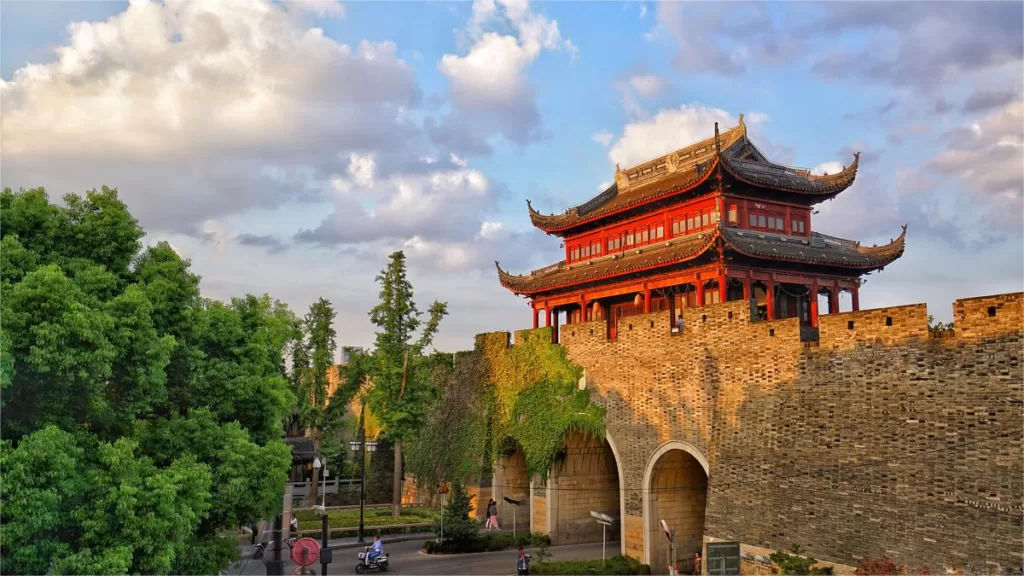Changmen Gate, Suzhou - TicKet Prix, heures d'ouverture, emplacement et points forts


Changmen Gate (阊门), one of the eight gates of Suzhou Ancient City, is situated in the northwest part of the city, leading towards the direction of Huqiu (Tiger Hill). The name “Chang” conveys the idea of connecting with the heavens, symbolizing the belief that the Wu State would receive blessings from the celestial deities, ensuring its prosperity. Additionally, due to Wu’s intention to conquer Chu, the gate is also known as “Pochu Men,” meaning “Breaking Chu Gate,” as it faces the direction of the Chu State.
The layout of Changmen Gate can be observed in the “Gusu Fanhua Tu” (Prosperous Suzhou Painting) in the Qing Dynasty during the reign of Emperor Qianlong. The inner city gate faces Changmen Street (now West Zhongshi Street), adorned with a tower. The outer city gate is accessed via a drawbridge, and the wengcheng (outer city) is rectangular in shape. Within the wengcheng, there is an additional set of walls known as the taocheng (inner city), and two gates named Nantongzi (South Child Mulberry) Gate and Beitungzi (North Child Mulberry) Gate. Nantongzi Gate leads to the present-day Nanxin Road, while Beitungzi Gate leads to the North Wharf. During the Taiping Rebellion, the wengcheng of Changmen Gate was destroyed, leaving only the inner city and taocheng. In 1927, during the construction carried out by the Municipal Preparation Bureau’s Engineering Department, the taocheng was dismantled, and the two small city gates were also removed.
Changmen Gate gained prominence not only for its historical significance but also due to its association with the most prosperous commercial district in Suzhou during the Ming and Qing dynasties. This area included the radiating streets outside the city such as Nanhao Street, Shangtang Street, and Shantang Street, as well as the inner city’s Changmen Street (now West Zhongshi Street). Parallel to these streets were the outer city canal, inner city canal, Shangtang River (ancient canal of the Beijing-Hangzhou Grand Canal), and Shantang River (leading to Huqiu), converging from five directions at Changmen Gate.
The famous paintings from the Qianlong period, such as “Gusu Fanhua Tu” and “Shengshi Zisheng Tu,” vividly portray the bustling scene of the ten-mile-long street from Changmen Gate to Fengqiao, where countless merchants gathered. During that era, the streets were lined with tens of thousands of shops, offering a wide variety of goods and services. Provincial guildhalls were also prominently present along these streets. In his work “Nan You Ji (Journal of Southern Trip),” Sun Jiagan of the Qing Dynasty vividly described Changmen Gate, stating, “Goods piled up like mountains, people flowed like water, shops with colorful signs were as splendid as cloud brocade.”
Informations de base
| Durée estimée de la visite | 0,5 - 1 heure |
| Prix du billet | Gratuit |
| Heures d'ouverture | 6.00 - 22.00 |
| Numéro de téléphone | 0086-0512-82112278 |
Localisation et transport
Located in the heart of Suzhou’s vibrant urban landscape, Changmen Gate is strategically positioned to connect the city’s modern pulse with its ancient origins. Its exact address is No. 521, Changxu Road, Gusu District, Suzhou, Jiangsu Province, Chine. Pour vous y rendre, vous pouvez choisir les moyens suivants :
Bus : Take bus 31, 54, 204, 501, 9020A, or 9029, get off at Changmen Hengjie Stop (阊门横街站), and walk about 250 meters to the west to reach the gate.
Métro : The closest metro station to Changmen Gate is Shilu (石路) on line 2, after getting out of the station from Exit 12, walk about 700 meters to the northeast to reach the gate.
Vlog about Changmen Gate
Attractions near Changmen Gate

Jardin de Yipu

Colline du tigre

Jardin de Liuyuan

Temple Xiyuan (Temple du Jardin Ouest)
Sites historiques du Jiangsu, Attractions de Suzhou